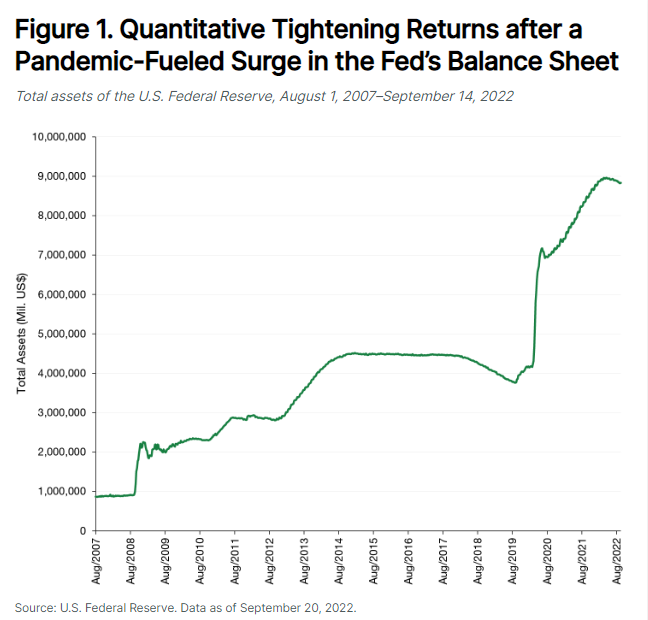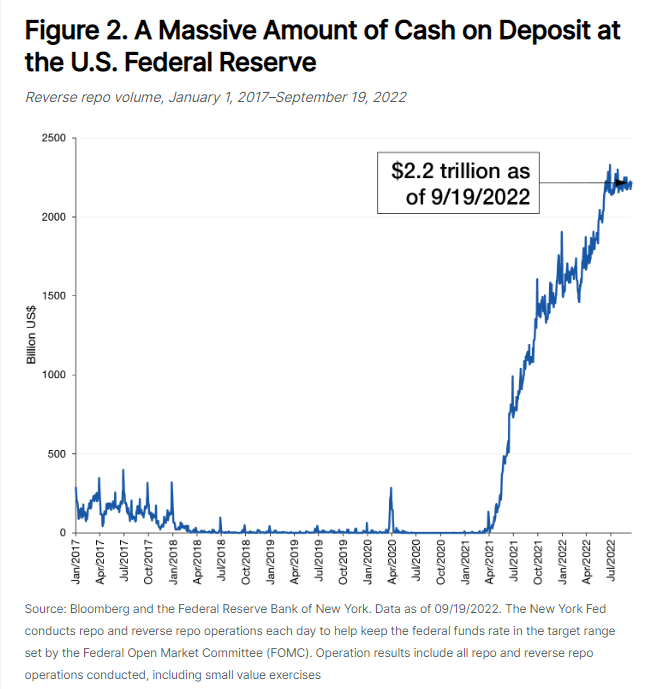Link para o artigo original : https://www.lordabbett.com/en-us/financial-advisor/insights/markets-and-economy/straight-talk-on-qt-and-market-liquidity.html
Insight • September 21, 2022 5 min. Read
Straight Talk on QT and Market Liquidity
We don’t think U.S. Federal Reserve policy moves to drain cash from the financial system via quantitative tightening will have a significant impact on how markets function. Here’s why.
While inflation data and rate hikes by the U.S. Federal Reserve (Fed) have dominated the financial news cycle, the Fed’s balance-sheet reduction efforts, known as quantitative tightening (QT), have spawned an intensifying amount of coverage. Widely read publications ranging from Barron’s to Bloomberg, along with a handful of Wall Street research analysts, have sounded the alarm about the catastrophic implications of a potential liquidity panic in the U.S. Treasury and funding markets.
DEFINITIONS
Quantitative easing, or QE, is a monetary policy whereby a central bank buys predetermined amounts of government bonds or other financial assets to add money directly into the economy. Such a program can substantially expand the size of the central bank’s balance sheet.
Quantitative tightening, or QT, refers to the opposite—policies that reduce the size of the central bank’s balance sheet. The U.S. Federal Reserve plans to implement this policy through runoff of the portfolio, not though actual asset sales.
The sentiment behind such articles is understandable; there were some hiccups associated with the Fed’s quantitative tightening efforts prior to the pandemic, and the magnitude and pace of the Fed’s balance-sheet reduction are even larger and faster this time around. Moreover, market liquidity, even in the massive, highly liquid, and “risk-free” U.S. Treasury market, has declined from pre-pandemic levels. Finally, investors are on edge and already concerned about the potential for “policy error” from the Fed. The last thing that markets, or the economy, need right now is a further destabilizing force.
Under the Fed’s recent program of quantitative easing (QE), its balance sheet reached a massive $9 trillion (see Figure 1); its effort to begin unwinding QE is an important topic. Anticipation of this reduction appears to have impacted valuations of affected assets (and will likely continue to do so as the program continues). Moreover, these types of articles play a critical role in drawing investor focus to areas of potential vulnerability in the financial system.

But we think the concerns that QT will destabilize markets are wildly overblown. Indeed, former FOMC Vice-Chair Bill Dudley felt compelled to respond in a recent op-ed,1 saying that another cash crunch in U.S. debt markets is very unlikely, and that investors should not be overly concerned. Given Dudley’s lengthy tenure on Wall Street and at the Fed, we believe his observations carry some significant weight. Moreover, we agree with them.
Some Historical Context on QE & QT
Cash and repo (repurchase agreement) markets are the lifeblood of the U.S. financial markets. Borrowers and lenders alike depend on the easy availability of funding for the smooth operating of transactions. When those markets seize up, as they did in the fall of 2008 at the onset of the global financial crisis (GFC) and again in the pandemic-disrupted month of March 2020, it can be devastating for markets. Unfortunately, there are few readily transparent benchmarks for investors to monitor the health of these short-term lending and borrowing markets; they are almost always taken for granted and only get noticed when something goes wrong. One such brief episode was in the fourth quarter of 2019, when repo rates (the rates that investors pay to borrow U.S. Treasury securities) spiked for the first time in a decade.
While this surge was fairly mild (such episodes were not unheard of prior to the GFC), it made headlines because it indicated that the era of excess cash in the financial system, created in large part by the Fed’s massive quantitative easing (QE) efforts following the 2008 financial crisis, had come to an end. And as with so many other periods of excess, flaws in the system went undiscovered—a system without a cash surplus had not been tested since the many significant regulatory changes created by the Dodd-Frank legislation in 2010.
Only a few months later, the pandemic-induced panic created a cash grab that roiled financial markets and exposed the vulnerabilities of the new system. Investors across the world tried to liquidate assets and hoard cash, and there simply wasn’t enough U.S. dollar-denominated cash in the system. Prior to the GFC, the Fed could address such imbalances by flooding the banking system with cash, which would in turn make its way rapidly into the rest of the market. However, the new regulatory framework had changed the plumbing of the monetary and banking systems. When the Fed flooded the banks with liquidity in March-April 2020, in response to the market panic and massive demand for cash, regulatory restrictions prevented banks from expanding their own balance sheets to get that cash to other investors.
The cash scarcity in the rest of the system led to an uncomfortable couple of weeks until the FOMC built new financial plumbing in an incredibly short amount of time. That effort included, among other things, a standing repo facility for banks, emergency currency-swap lines for central banks of major U.S. trading partners, and the ability for money markets to access Fed financial facilities. Those important new liquidity mechanisms are still in place, as is the Fed’s assurance that they will do what is necessary to ensure the proper functioning of financial markets.
One post-GFC facility worth highlighting is the Fed’s reverse repo operations. Created to avoid unduly punishing banks via low fed funds rates and excess liquidity at a time when banks were still reeling from the GFC, the reverse repo facility allows banks and money market funds to deposit excess cash at the Fed and earn a reasonable rate of return when there are no other outlets for that cash. Those volumes have exploded in the past 12 months, as seen in Figure 2.

Critics will note that much of this volume has come from money market funds, not from banks, and so it does not necessarily indicate excess liquidity in the banking system. While true, this observation seemingly overlooks the fact that, when taken as a whole, the money market ecosystem, that includes both bank deposits and money market funds, still has roughly $2 trillion in cash that lacks an investment home. The Fed is running off its balance sheet at a rapid rate of slightly less than $1 trillion per year. Even if we do reach the unlikely point where the Fed has drained enough cash from the system to make a cash squeeze possible, and the liquidity lines that worked so well to reverse the panic during the pandemic fail to make a difference, that problem will only occur well into the future.
We should also observe that Fed policy makers, while human and just as vulnerable to errors as the rest of us, do learn from their mistakes, and have important experience from the 2017-2019 round of QT to draw upon. More technical aspects of the cash markets, such as the pace of Treasury bill issuance, have been carefully thought out and coordinated with the Treasury department to drain liquidity at a far more modest pace than in 2019.
The Fed has made clear that it wants to do what it can to fight inflation, and this effort has rightly drawn the attention of many investors; however, damaging market liquidity does not further this goal in any way, and the Fed has emphasized that it places an enormous priority on maintaining healthy and functioning markets (including markets that may reprice violently with economic news—a sign of market health, if a sometimes uncomfortable one). Market volatility, far from being a warning sign of impending liquidity doom, is instead a natural and healthy result for markets to price economic uncertainty and the Fed’s recent paradigm shift regarding monetary policy.
Summing Up
Markets have faced many challenges in 2022, and the potential for further volatility remains high. Investors are uncertain, and hawkish Fed policy is front and center of today’s news cycle; few environments lend themselves more readily to the current spate of doomsaying. However, we would reiterate Bill Dudley’s point mentioned earlier: while the pace of the Fed’s quantitative tightening may have important implications for interest-rate markets, the combination of existing liquidity facilities, plus the Fed’s clear willingness to act as needed to maintain proper market functioning, means that these alarming predictions are overwrought. There are many things to worry about regarding today’s markets and economy, including the potential consequences of the Fed’s monetary policy. In our view, the notion that funding markets will seize up because the Fed is draining cash from the financial system is not one of them.
About the Author
Tim Paulson engages regularly with Lord Abbett’s clients around the world, articulating the firm’s views on economic outlook and capital markets, as well as practical applications of Lord Abbett’s investment strategies.
As informações aqui contidas estão sendo fornecidas pela GAMA Investimentos (“Distribuidor”), na qualidade de distribuidora do site. O conteúdo deste documento [e informações neste site] contém informações proprietárias sobre LORD ABBETT e o Fundo. Nenhuma parte deste documento nem as informações proprietárias do LORD ABBETT ou DO Fundo aqui podem ser (i) copiadas, fotocopiadas ou duplicadas de qualquer forma por qualquer meio (ii) distribuídas sem o consentimento prévio por escrito do LORD ABBETT. Divulgações importantes estão incluídas ao longo deste documento e que devem ser utilizadas exclusivamente para fins de análise do LORD ABBETT e do Fundo. Este documento não pretende ser totalmente compreendido ou conter todas as informações que o destinatário possa desejar ao analisar o LORD ABBETT e o Fundo e/ou seus respectivos produtos gerenciados ou futuramente gerenciados. Este material não pode ser utilizado como base para qualquer decisão de investimento. O destinatário deve confiar exclusivamente nos documentos constitutivos de qualquer produto e em sua própria análise independente. Nem o LORD ABBETT nem o Fundo estão registrados ou licenciados no Brasil e o Fundo não está disponível para venda pública no Brasil. Embora a Gama e suas afiliadas acreditem que todas as informações aqui contidas sejam precisas, nenhuma delas faz qualquer declaração ou garantia quanto à conclusão ou necessidades dessas informações.
Essas informações podem conter declarações de previsões que envolvem riscos e incertezas; os resultados reais podem diferir materialmente de quaisquer expectativas, projeções ou previsões feitas ou inferidas em tais declarações de previsões. Portanto, os destinatários são advertidos a não depositar confiança indevida nessas declarações de previsões. As projeções e/ou valores futuros de investimentos não realizados dependerão, entre outros fatores, dos resultados operacionais futuros, do valor dos ativos e das condições de mercado no momento da alienação, restrições legais e contratuais à transferência que possam limitar a liquidez, quaisquer custos de transação e prazos e forma de venda, que podem diferir das premissas e circunstâncias em que se baseiam as perspectivas atuais, e muitas das quais são difíceis de prever. O desempenho passado não é indicativo de resultados futuros.


